|
Variations on the Trombone
Trombones of today
First of all, one needs to recognize the many varieties of the modern
trombone.
|
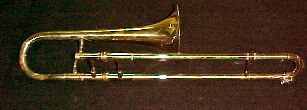
|
Only 21 inches in length, the Soprano Trombone--or
slide trumpet--is not used regularly for orchestral or band music.
Though having the appearance of a trombone, this instrument is usually
played by a trumpet player as the mouthpiece and playing range is the
same as a trumpet, pitched in Bb, an octave above the tenor
trombone. |
There are trombones pitched even higher than the soprano--the sopranino,
and the highest, the piccolo--but these are rarely seen and are only used in
large trombone choirs. To see a collection with the widest range of
trombones, plus get info on trombone ensembles, check out
Tom Izzo's
page.
Below are descriptions of modern trombones. There will be slight
variations among different manufacturers and some will not offer as many
bore (tubing diameter) size options, but most will follow these basic
designs:
 |
Alto Trombone
Pitched a perfect fourth higher, in Eb, and smaller than
the tenor trombone, it has a small bore and is used often in church
brass music and in brass ensembles to provide the top voice. |
 |
Tenor
Trombone (small bore)
This is the most common type of trombone used today. It is, as the
remaining trombones are, pitched in Bb. The bore size is
anywhere from .468" - .490". Small bore horns have the brightest sound
and are often preferred in jazz groups to cut through when soloing. |
 |
Medium
bore Tenor Trombone
The bore size is typically .500" - .509". As bore size increases, the
timbre of the horn becomes "rounder or darker", less brilliant. This is
a sound sought after in orchestral work. |
 |
Medium-large bore Tenor Trombone (with "traditional wrap" F
attachment)
Bore size typically .525"
The F attachment adds a wrap of tubing activated by a trigger and
rotor valve which lowers the fundamental pitch from Bb to F.
This allows the player to reach lower notes than would otherwise be
possible. Horns of this size and larger are available in "traditional"
or "open" wraps or without the F attachment. |
 |
Large
Bore Tenor (with "open wrap" F attachment)
Bore size typically .547"
The "open wrap" eliminates the tight turns of the traditional wrap,
improving airflow through the F tubing, and is preferred by many
professionals. |
 |
Bass
Trombone
The largest bore measuring at typically .562" and also the largest bell
(10-10.5")
Although there are single-rotor bass trombones, many now include a
second valve which can work independently of the first--or may be
"dependent" and used in combination with the first. The extra valve
allows more pitch changing and flexibility to the professional player. |
 |
Valve
Trombone
This model is typical of most valve trombones you will find today. They
usually have a small to medium bore. The valve fingering is the same as
a trumpet. Many are sold with a conventional slide section as well for
the player who wants both options. Not used in orchestras or most
bands, this style is popular in some jazz ensembles and for trumpet and
euphonium players who want to "double" on trombone. |
That certainly would be enough to keep most people confused. The
different bore sizes are the most common innovation of trombone development
in the twentieth century with the tendency toward larger bore horns being
more popular in the second half of the century. Many brass makers take
specifications from players and turn out custom horns. It is from these
innovations during the 1900's that we can now not only specify bore size and
finish, but also specify different valves for the F attachment,
interchangeable bells and leadpipes, and slides. Today, we have many
choices in selecting a trombone.
Now, for the more unusual versions of the trombone you might see today.
|
 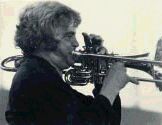

above: Jim Self's custom 'Minick Super Bass Trombone'

|
What do you get when you cross a valve trombone with a
slide trombone?
The answer is Holton's "Superbone".
Both the slide and the valves can be used simultaneously using the
left hand to operate the valves.
The horn was made somewhat famous by trumpeter Maynard Ferguson
(shown at left).
Conn also made a similar type trombone.
As radical as this may seem, this is not a modern idea. Combining
the valve and slide trombone was considered many years earlier.
The last photo is of a turn-of-the-century combination valve/slide
trombone made by Lehland. |
|
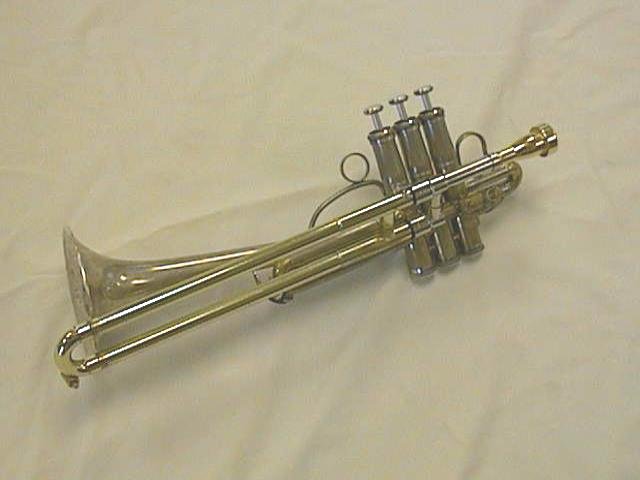
|
How about creating a valved trumpet with a trombone-like
slide?
For the story behind the "Zephyros", click on the picture to
the left. |
|
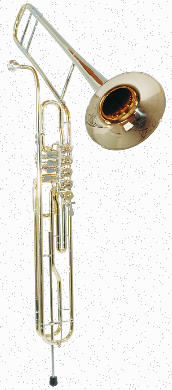 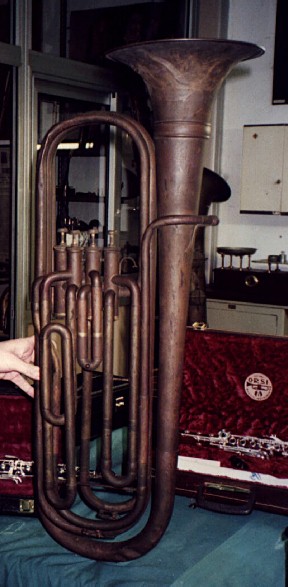
|
While not
found in all orchestras, if you attend a Verdi opera you might see the Cimbasso ("chim-BOSS-o") in the low brass section.
Pictured on the left, looking like a big bass trombone that got bent
somehow, this is actually an instrument for the tuba player to use. It
is a valved instrument, usually found with rotor valves. It has the
range of a tuba with the sonic properties of a trombone--brassy rather
than full and mellow. Note the rubber-tipped rod at the bottom to
support the instrument.
On the right, an older tuba-style cimbasso.
There are other variations made to play in different keys as well. |
|
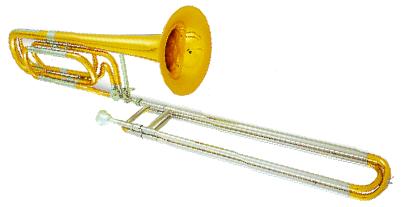
|
The
contrabass trombone is not a new instrument. Like the
cimbasso, it is pitched an octave lower than the tenor trombone.
Due to its low range, most modern versions have a doubled slide. The
instrument pictured is a Mirafone Contrabass Trombone. |
|
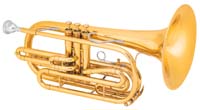
|
With the
popularity of Drum and Bugle Corps organizations starting in the 1950's
and 60's, many manufacturers came up with a line of instruments
collectively called Marching Brass.
This is the King "Flugabone". It is what you would
have if you took a valve trombone and wrapped up the tubing like a
flugelhorn, hence the name. Pitched in Bb and using a trombone
mouthpiece, it has an 8½" bell and .500" bore. |
|
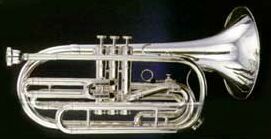
|
Similarly
styled (and named), the "Flugelbone" made by Kanstul Music
Northwest is designed for marching. It has a 9½" bell and a .509" bore. |
|

|
Here is the "JazzBone" from DEG Music Products. Produced around 1985,
this instrument couples a traditional bell section with a tightly
wrapped valve section. DEG was established in 1964 by Donald E. Getzen,
son of Getzen Company founder T.J. Getzen. |
|
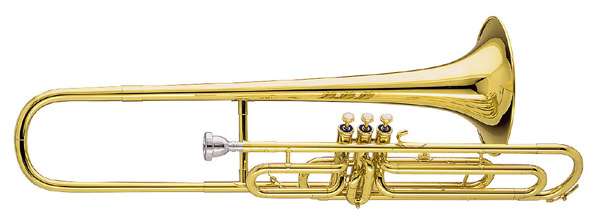
|
This is a a
"jazz model" valve trombone by Amati. It has a .488" bore and 7" bell.
It resembles a traditional valve trombone but the front end is
considerably shorter due to its wrap design. |
|
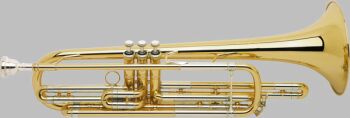
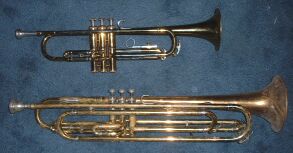
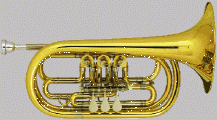
|
Okay, it's
not a trombone--but it's played by a trombone player.
This is a Bb bass trumpet. Attend a
performance of Wagner's The Ring and you might see one in the
orchestra. It has the same range as a trombone, pitched an octave below
the standard Bb trumpet.
In the middle photo, a size comparison with a standard trumpet above;
a Holton bass trumpet below.
The bottom photo is of a German-style bass trumpet with three rotary
valves. |
|

|
If you've
ever seen the long, straight Herald Trumpet, you'll note the similarity
in styling of this octave-lower Bb Tenor Fanfare
Trumpet made by Besson. It has a .487" bore and 5.75" bell.
There is also a slightly larger Bass Fanfare Trumpet in Bb
with a .580" bore. It can accommodate a flag or banner hanging from its
bell! |
|
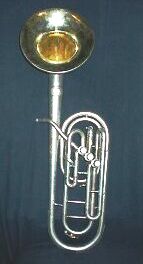 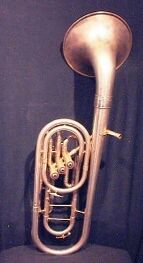 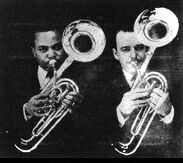
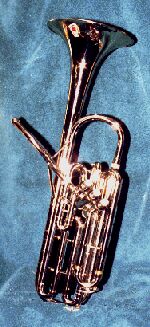 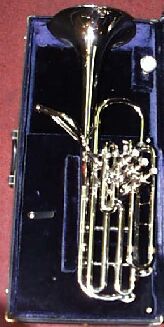
|
Cross a trombone with a euphonium and you get the Trombonium.
Made by King starting in the late 1930's (originally, the "Trumbonium"),
this was an instrument originally designed for marching and mounted
bands which could deliver a trombone sound without an ungainly slide.
Note the narrow bore.
In the 1950's, it was popularized in jazz circles by J.J. Johnson and
Kai Winding (pictured at left). King continued production of this horn
into the 1970's.
Trombonium's eventual change to a "bell-up" design
similar to the Conn model (below)
The two "bell-up" models shown are trombonium-style horns for
marching made by (left) the F.E. Olds & Son Co. of Los Angeles and
(right) C.G. Conn, model 90G.
Musical Note:
"Trombonium" is also the title of an early
1900's ragtime march by Lathrop Withrow featuring lots of trombone
glissandos and similar in style to the popular "Lassus Trombone"
by Fillmore. Recommended playing for any fun-loving
trombone player.
|
|
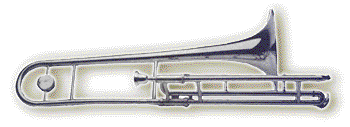
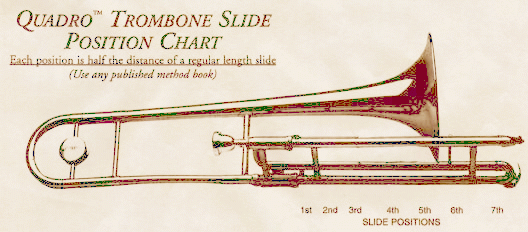
|
The
Quadro® Slide. It's a full length
slide folded over so each slide position is half the distance of a
regular slide.
Stated benefits include: easier to play more complicated passages;
small players and beginners can reach seventh position; ideal for
marching band maneuvers; available in .508", .547" and .562" bore; slide
available separately to use with an existing bell.
Made by DEG Music Products. |
|
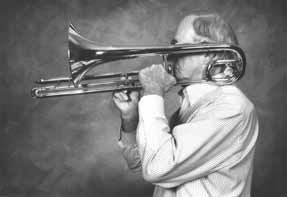

|
If the
Quadro is still too big, try a "ShortBone".
It has a shorter bell section married to the Quadro slide OR a
short valve section! The valve model is 29 inches long and the Quadro
slide model is only 27 inches long!
Also available is a short Eb slide trombone, a C valve
trombone, and a ShortBone Bb Soprano Trombone/Slide Trumpet at
18½ inches long!
Brand new and made by DEG as well! |
|
Some real bizarre variations and non-horns
|
|
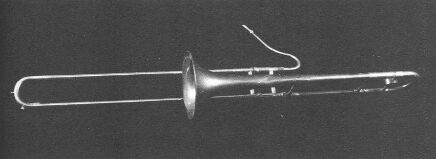
|
This is a Tromboon. An invention of P.D.Q. Bach (read "Peter
Schickele") and required instrument in the playing of P.D.Q. Bach's
Serenude for devious instruments (S. 36-24-36) |
|
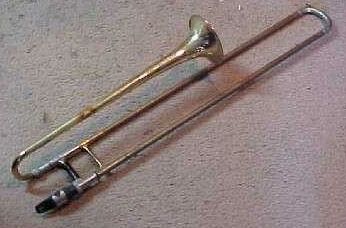
|
A definite
"one-off" insturment is this SaxOBone which was custom
made using a trombone slide, a trumpet bell, and a baritone sax
mouthpiece. It was seen on eBay and the new "lucky" owner, with much
practice, can probably create sounds such as the following sample from
its creator.
(267K
.wav file) |
|

|
The
Golden Trombone is a toy which was made in the 1950's. It is
technically not a horn, but rather a harmonica-type toy. As you blow
air in and pull the slide, the notes descend through a major scale. It
comes with a music lyre and a songbook so you can play familiar tunes.
The Emenee Company made an entire line of musical toys so you and your
friends could form your own band! |
|

|
The
Trombone Kazoo is simply a kazoo with a bell and slide (which
does work, although not affecting the sound). You play it like any
kazoo--by humming the tune into the mouthpiece. |
|


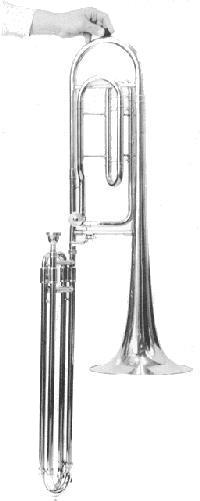
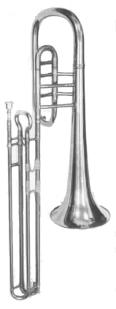
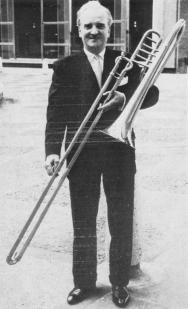




































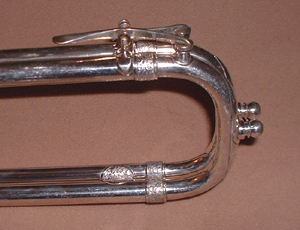 A close up view
(left) of the ingenius
A close up view
(left) of the ingenius 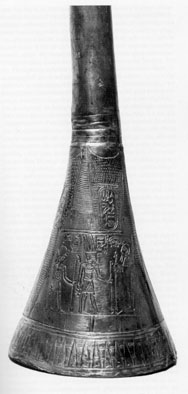 The bell of the silver trumpet found in the tomb of Tut-ank-amen
The bell of the silver trumpet found in the tomb of Tut-ank-amen